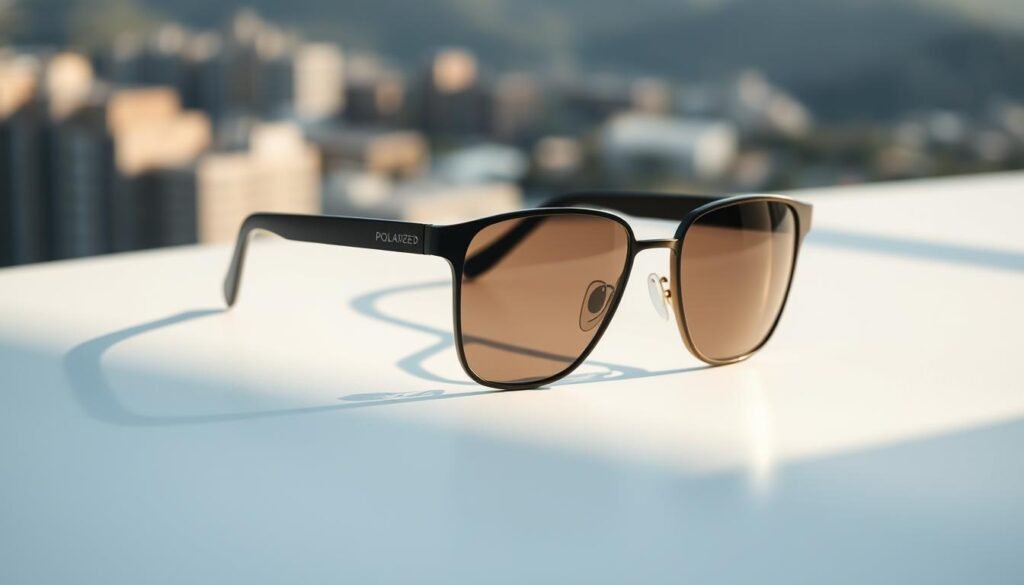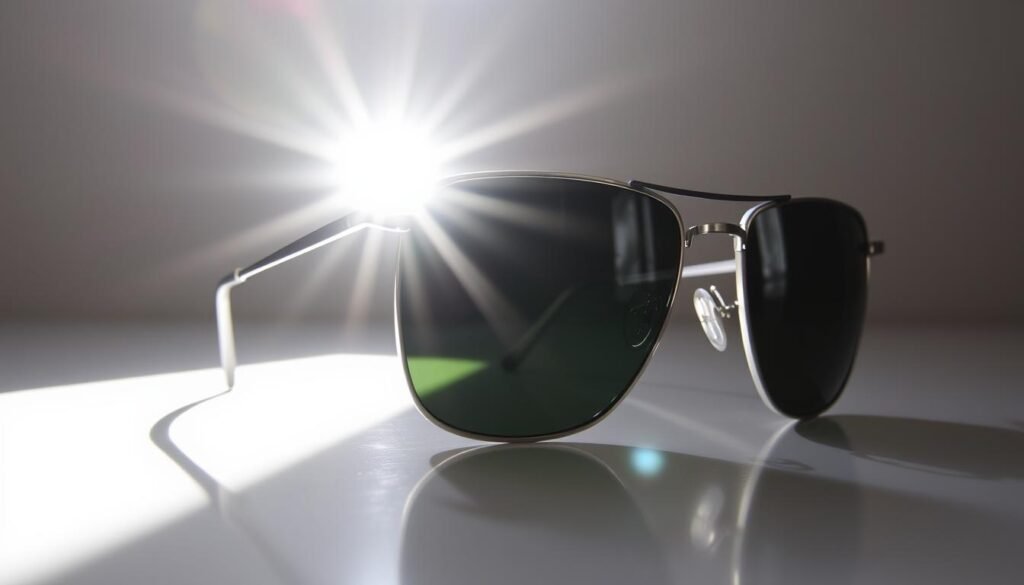You’ve probably heard polarized lenses are the gold standard for cutting glare. They’re a top pick for outdoor enthusiasts, drivers, and anyone chasing crisp vision on sunny days. But here’s the twist: these lenses aren’t perfect for every situation. Let’s explore why “better” doesn’t always mean “best” for your eyes.
Specialized eyewear works by filtering horizontal light waves, which reduces reflections from water, snow, or roads. That’s great for fishing or beach trips! However, this same feature can backfire during certain activities. For example, pilots and skiers might struggle with LCD screens or icy terrain details.
Choosing the right pair isn’t about price tags or trends—it’s about how you use them. Night driving, digital screen clarity, and even specific jobs can make non-polarized options smarter. This guide will unpack the science and real-world scenarios where swapping lenses could save you from headaches (literally).
Key Takeaways
- Polarized options excel at reducing glare but can distort LCD screens
- Nighttime driving often requires different eye protection
- Certain professions benefit from non-polarized eyewear
- Activity-specific needs trump generic marketing claims
- Price doesn’t always reflect functional superiority
Understanding the Science Behind Polarized Lenses
Ever wonder how some sunglasses magically erase reflections? It’s all about the way light travels. Natural sunlight scatters in every direction, creating soft shadows. But when it hits flat surfaces like lakes or roads, it flattens into intense horizontal waves—that’s the glare that makes you squint.
How Polarized Lenses Reduce Glare
Think of these special glasses as microscopic picket fences. Vertical slats in their chemical filter let only vertical light waves through. Horizontal waves—the ones causing glare—get blocked. This trick works because reflected light aligns parallel to shiny surfaces.
The Role of Light Polarization and Filters
Here’s the cool part: the filter isn’t just tinted plastic. A thin layer of iodine crystals gets stretched during manufacturing to create those “slats.” This scientific approach targets specific light orientations, not just brightness. It’s why anglers spot fish underwater but pilots might miss dashboard warnings.
| Light Type | Surface | Effect |
|---|---|---|
| Unpolarized | Rocks, grass | Soft, even light |
| Polarized | Water, snow | Harsh glare |
| Filtered | Any | Reduced eye strain |
The Pros and Cons of Using Polarized Lenses
Ever notice how some shades transform bright chaos into crystal-clear views? Specialized eyewear designed to combat glare offers distinct advantages—but also some surprising compromises. Let’s break down what these sunglasses do well and where they might leave you squinting.
Sun Warriors: Where They Shine
These glare-fighting champions excel in outdoor settings. By filtering horizontal light waves, they:
- Reveal hidden details on water surfaces (perfect for spotting fish)
- Boost color richness in landscapes and skies
- Cut reflection-induced headaches by up to 40% (per optometry studies)
Drivers appreciate sharper road views, while hikers see trails more vividly. The secret? A chemical filter that works like microscopic venetian blinds for your eyes.
Hidden Trade-Offs
However, these advantages come with trade-offs. Digital screens often become unreadable—car dashboards might darken unexpectedly. One skier reported nearly missing a trail marker because her goggles muted an LCD temperature display.
| Scenario | Benefit | Drawback |
|---|---|---|
| Beach Day | Clear water visibility | Phone screen harder to read |
| City Driving | Reduced road glare | GPS navigation issues |
| Winter Sports | Better snow contrast | Icy patch detection challenges |
While ideal for sunny adventures, these sunglasses aren’t one-size-fits-all. Night drivers and tech-reliant professionals often prefer alternatives. The key? Match your eyewear to your activity—not the marketing hype.
When Polarized Lenses Can Enhance Outdoor Experiences
Ever tried spotting fish beneath sun-dappled water or reading road signs through windshield glare? Certain activities demand more than standard sun protection. Specialty eyewear designed to combat intense reflections can elevate your experience in surprising ways.
Water Warriors’ Secret Weapon
Anglers and surfers swear by these glare-cutting marvels. Here’s why:
- Spot fish shadows and underwater currents through mirrored surfaces
- Track wave patterns without squinting at sun-kissed oceans
- Navigate rocky riverbeds while kayaking or paddleboarding
Boaters report seeing submerged logs 30% faster compared to regular sunglasses. The secret? A filter that strips away surface sparkle like peeling cellophane from water.
Road Trip Game Changers
Daytime drivers gain three crucial advantages:
- Clear view of wet asphalt patterns during sudden rain
- Reduced dashboard reflections in bright conditions
- Better visibility of cyclists’ movements beside traffic
Pro tip: These perform best between 10 AM–4 PM when sunlight angles create maximum glare. Pair them with UV protection for complete eye safety.
Hikers and golfers benefit too. Enhanced color contrast helps read terrain variations, while reduced eye strain lets you enjoy longer days outdoors. One mountain biker described it as “switching from standard TV to 4K resolution” for trail features.
When Not to Use Polarized Lenses: Safety Considerations
Imagine gearing up for a night drive only to realize your eyewear makes dark roads murkier. While glare-reducing options shine in sunlight, they create risks in specific scenarios. Here’s where smart choices prevent accidents.

Digital Display Dilemmas
Professionals relying on screens face unique challenges. Pilots often report dashboard warnings appearing “washed out” through specialized glasses. Heavy machinery operators might miss critical alerts on LCD panels. Why? These screens emit polarized light that clashes with filter layers.
Nighttime Navigation Risks
Wearing sunglasses after sunset reduces visibility for everyone. Studies show reaction times slow by 0.2 seconds in low light—enough to miss a pedestrian. While all tinted eyewear dims roads, polarized versions can distort raindrop reflections that help drivers gauge speed.
Winter’s Hidden Ice Problem
Skiers and snowboarders need glare to spot danger. A Utah avalanche instructor shared: “That shiny patch you’d avoid? It disappears through filtered lenses.” Ice detection relies on light reflections that specialized eyewear removes.
| Scenario | Risk | Solution |
|---|---|---|
| Airplane cockpit | Missed instrument readings | Anti-glare non-polarized |
| Night driving | Reduced depth perception | Clear safety glasses |
| Ski slopes | Undetected ice sheets | Yellow-tinted eyewear |
These situations don’t mean your glasses are faulty—they’re just mismatched to the task. Always pair your eyewear with your environment’s demands.
Polarized Lenses vs. Non-Polarized Sunglasses
Choosing eyewear often feels like navigating a maze of technical terms. Let’s simplify the key differences between these two sun protection strategies. One tackles blinding reflections, while the other offers balanced light control.
Light Management Showdown
Non-polarized options work like window shades—they dim everything evenly. This approach reduces brightness but leaves glare from water or roads untouched. Polarized versions act as specialized filters, blocking horizontal light waves that cause squint-inducing reflections.
Here’s what many miss: both types can block 100% of UV rays. The “UV400” label matters more than polarization for protecting your eyes from the sun’s harmful effects. Always check certification stamps, not marketing claims.
When Simplicity Wins
Consider these factors before deciding:
- Drivers who read digital dashboards often prefer non-polarized clarity
- Beachgoers and boaters gain more from targeted glare reduction
- Price gaps of $20-$80 reflect tech, not necessarily UV protection quality
An optometrist notes: “Patients assume pricier means safer. I’ve seen $25 non-polarized glasses outperform $150 polarized ones in UV blocking.” Your activities—not price tags—should guide your choice.
Ultimately, both options protect against the sun when properly certified. Polarized models excel in specific scenarios, while non-polarized shades offer versatile performance. Match your selection to your daily demands, not the sales pitch.
Exploring the Benefits of polarized lenses
Picture sunglasses that do more than just dim sunlight—they reveal hidden details. High-quality options with specialized filters transform harsh glare into crisp visibility. These glasses block 99.9% of blinding reflections while enhancing color depth, making them ideal for bright adventures.

Seeing Beyond the Glare
Premium filters remove specific light wavelengths that wash out colors. By targeting harsh yellow tones, they amplify reds, greens, and blues. This explains why anglers spot fish shadows underwater and hikers see trail textures more clearly.
Advanced materials like Costa’s 580 lenses demonstrate this tech. They filter light at 580 nanometers—the sweet spot for balancing UV protection and visual clarity. Whether glass or polycarbonate, these options prove why quality matters more than marketing claims.
Investment That Pays Off
While pricier than basic shades, top-tier options deliver measurable advantages:
- Glass versions resist scratches during rocky beach hikes
- Polycarbonate styles stay lightweight for all-day comfort
- Multi-layer coatings maintain performance for years
A marine biologist shared: “My Costa glasses survived three fishing seasons. They’re the reason I spot coral changes faster.” This durability justifies higher costs when your eyes depend on reliability.
From golfers reading subtle green slopes to photographers capturing true hues, these benefits impact both safety and enjoyment. The right pair becomes an extension of your skills—not just sun protection.
Considerations for Eye Health and UV Protection
Your eyes face silent threats every sunny day. Ultraviolet rays don’t just cause squinting—they can permanently damage vision. Understanding how to shield your eyes goes beyond picking stylish frames.
Why UV Defense Matters
Prolonged sun exposure increases risks for cataracts and macular degeneration. Even brief exposure can cause photokeratitis—a painful corneal sunburn. Symptoms include blurred vision and light sensitivity, often lasting 48 hours.
Decoding Sunglass Labels
Look for UV400 or 100% UV protection stamps—these block harmful rays completely. Cosmetic glasses might only filter 60% of UV light. Remember: dark tints don’t equal protection. A clear lens with UV coating beats black lenses without it.
| Label | Meaning | Protection Level |
|---|---|---|
| UV400 | Blocks rays up to 400nm | Full spectrum |
| Polarized | Reduces glare only | No UV guarantee |
| Cosmetic | Style-focused | Partial filtering |
Choose wraparound styles for side coverage. Larger frames block 98% of stray rays compared to 85% with smaller designs. Pair sunglasses with wide brim hats for maximum defense.
Eye care experts stress: “UV damage accumulates over time. Start protecting early—even kids need quality shades.” Prioritize certified protection over trends to safeguard your sight.
Practical Usage Scenarios: When to Avoid Polarized Lenses
Smart eyewear choices depend on knowing when specialized features work against you. While glare-cutting technology shines in bright settings, specific scenarios demand different solutions.
When Screens and Safety Collide
LCD displays in planes or construction equipment often clash with polarized sunglasses. The filter can make warning lights look dim or distorted. Pilots report dashboard numbers appearing “chopped” mid-flight.
Night driving presents another challenge. These glasses reduce already-low light levels, making dark roads riskier. One truck driver shared: “I missed a deer crossing until it was too close—switched to clear anti-glare options next day.”
Icy roads and wet surfaces require seeing reflections. Polarized versions strip away the sparkle that helps spot black ice. Ski instructors often use yellow-tinted eyewear instead for better contrast.
Whether you’re operating heavy machinery or walking city streets after rain, your eyewear choice impacts safety. Match your options to the environment—not just the sunshine.

